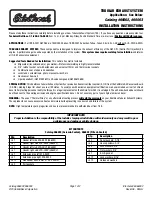
243
Operation
Tires and wheels
Tire pressure changes by approximately
1.5 psi (0.1 bar) per 18°F (10°C) of air
temperature change. Keep this in mind
when checking tire pressure where the
temperature is different from the outside
temperature.
The tire temperature and with it the tire
pressure is increased also while driving,
depending on the driving speed and the
tire load.
Check the spare tire periodically for condi-
tion and inflation. Spare tire will age and
become worn over time even if never used,
and thus should be inspected and replaced
when necessary.
Rotating wheels
The wheels can be rotated every 3000 to
6000 miles (5000 to 10000 km), or soon-
er if necessary, according to the degree of
tire wear. The same direction of tire rota-
tion must be retained.
Rotate the wheels before the characteris-
tic tire wear pattern becomes visible
(shoulder wear on front wheels and tread
center wear on rear wheels).
Thoroughly clean the inner side of the
wheels after each rotation. Check and en-
sure proper tire inflation pressure.
i
The pressures listed for light loads are
minimum values offering high driving
comfort.
Increased inflation pressures listed for
heavier loads may also be used for light
loads. These higher pressures produce
favorable handling characteristics. The
ride of the vehicle, however, will be
somewhat harder. Never exceed the
max. values or inflate tires below the
min. values listed in the fuel filler flap.
Warning!
G
Follow recommended inflation pressures.
Do not overinflate tires. Overinflated tires
can result in sudden deflation (blowout) be-
cause they are more likely to become punc-
tured or damaged by road debris, potholes
etc.
Do not underinflate tires. Underinflated tires
wear unevenly, adversely affect handling
and fuel economy, and are more likely to fail
from being overheated.
Do not overload the tires by exceeding the
specified vehicle capacity weight (as indicat-
ed by the label on the pillar in the driver’s
door opening). Overloading the tires can
overheat them, possibly causing a blowout.
Warning!
G
Have the tightening torque checked after
changing a wheel. Wheels could become
loose if not tightened with a torque of
80 ft.lb. (110 Nm).
Use only genuine Mercedes-Benz wheel
bolts specified for your vehicle's rims.
S203 MY03_A.book Page 243 Tuesday, January 28, 2003 2:22 PM
Summary of Contents for 2003 C-Class Wagon
Page 1: ...C 240 C 240 4MATIC C 320 C 320 4MATIC S203 MY03_A book Page 1 Tuesday January 28 2003 2 22 PM...
Page 14: ...20 At a glance Cockpit Cockpit S203 MY03_A book Page 20 Tuesday January 28 2003 2 22 PM...
Page 48: ...54 S203 MY03_A book Page 54 Tuesday January 28 2003 2 22 PM...
Page 76: ...82 S203 MY03_A book Page 82 Tuesday January 28 2003 2 22 PM...
Page 310: ...316 S203 MY03_A book Page 316 Tuesday January 28 2003 2 22 PM...
Page 338: ...344 S203 MY03_A book Page 344 Tuesday January 28 2003 2 22 PM...
Page 363: ...S203 MY03_A book Page 369 Tuesday January 28 2003 2 22 PM...
Page 364: ...S203 MY03_A book Page 370 Tuesday January 28 2003 2 22 PM...
Page 365: ...S203 MY03_A book Page 371 Tuesday January 28 2003 2 22 PM...
Page 366: ...S203 MY03_A book Page 372 Tuesday January 28 2003 2 22 PM...
Page 367: ...S203 MY03_A book Page 373 Tuesday January 28 2003 2 22 PM...
Page 368: ...S203 MY03_A book Page 374 Tuesday January 28 2003 2 22 PM...
Page 370: ...S203 MY03_A book Page 376 Tuesday January 28 2003 2 22 PM...
















































